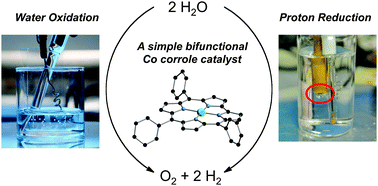Electrochemical, spectroscopic and theoretical studies of a simple bifunctional cobalt corrole catalyst for oxygen evolution and hydrogen production†
Abstract
Six cobalt and manganese corrole complexes were synthesized and examined as single-site catalysts for water splitting. The simple cobalt corrole [Co(tpfc)(py)2] (1, tpfc = 5,10,15-tris(pentafluorophenyl)corrole, py = pyridine) catalyzed both water oxidation and proton reduction efficiently. By coating complex 1 onto indium tin oxide (ITO) electrodes, the turnover frequency for electrocatalytic water oxidation was 0.20 s−1 at 1.4 V (vs. Ag/AgCl, pH = 7), and it was 1010 s−1 for proton reduction at −1.0 V (vs. Ag/AgCl, pH = 0.5). The stability of 1 for catalytic oxygen evolution and hydrogen production was evaluated by electrochemical, UV-vis and mass measurements, scanning electron microscope (SEM) and energy dispersive X-ray spectroscopy (EDX), which confirmed that 1 was the real molecular catalyst. Titration and UV-vis experiments showed that the pyridine group on Co dissociated at the beginning of catalysis, which was critical to subsequent activation of water. A proton-coupled electron transfer process was involved based on the pH dependence of the water oxidation reaction catalyzed by 1. As for manganese corroles 2–6, although their oxidizing powers were comparable to that of 1, they were not as stable as 1 and underwent decomposition at the electrode. Density functional theory (DFT) calculations indicated that water oxidation by 1 was feasible through a proposed catalytic cycle. The formation of an O–O bond was suggested to be the rate-determining step, and the calculated activation barrier of 18.1 kcal mol−1 was in good agreement with that obtained from experiments.


 Please wait while we load your content...
Please wait while we load your content...